

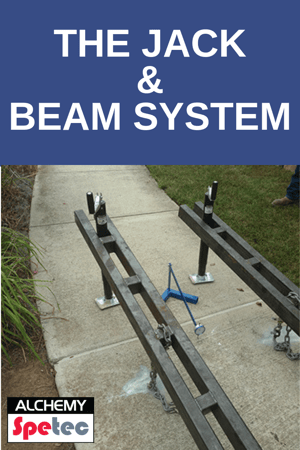 Note: This product is no longer available.
Note: This product is no longer available.
Please see: Jack Attack System.
The Jack & Beam System provides mechanical leverage for guiding the lift direction of slabs or holding them in place while filling voids beneath.
Advantages
Improves accuracy of final slab position.
Helps prevent over-lifting.
Works with a variety of concrete anchors.
Cuts down on wasted foam.
System Components
Two steel structural beams.
Four mechanical jacks.
Accessories kit with chains, hooks and clevices.
Want more information on Alchemy-Spetec Geotech products?
Topics: All Posts, Lift Slabs, Stabilize Soil, Deep Lift


When your reputation is on the line, we’ve got you covered.
Sidewinder Scuff Guard incorporates the most advanced
insulation and abrasion-resistant materials to enhance application
and provide higher yields when pushing foam.
Available in both insulated and non-insulated versions, Sidewinder installs in minutes and offers unmatched hose protection from heavy abrasion, moisture, and temperature energy loss.
Forget the duct tape and nylon sock! Bundle up with Sidewinder’s “all-season” Scuff Guard from Alchemy-Spetec.
- RUGGED SIMPLICITY. Sidewinder’s sleek, low-profile design makes dragging hose a breeze.
- OPTIMIZED FOR SPF. Sidewinder’s specialized cover provides added protection in wet, high UV applications and remains extremely flexible in temperatures from -60°F to 250°F.
- UP TO 60% ENERGY SAVINGS. Insulated sleeve can reduce temperature loss by up to 60%.
- GETTING HEATED? Sidewinder Scuff Guard helps control viscosity & reduces wear to proportioners eliminating these headaches:
- Inability to maintain ideal temperatures under varying conditions
- Hours spent repairing heavy hose sock & replacing tattered duct tape
- Replacing costly FTS cables, FTS sensors & defective whips
- Loss of yield, cutting into profits
Want more information on Alchemy-Spetec Geotech products?
Topics: Equipment & Accessories, All Posts, Lift Slabs, Deep Lift

Alchemy-Spetec has added 4 new items to our product line!
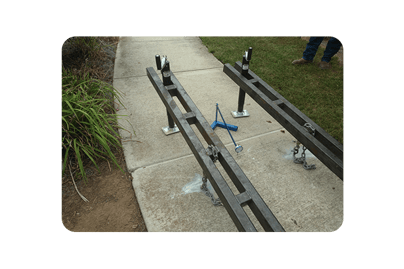 Jack & Beam System
Jack & Beam System
The Jack & Beam System provides mechanical leverage for guiding the lift direction of slabs or holding them in place while filling voids beneath. This invaluable tool provides polyurethane slab lifters with a distinct advantage in precision slab placement.
The system includes 2 beams, 4 jacks and all the necessary hardware.
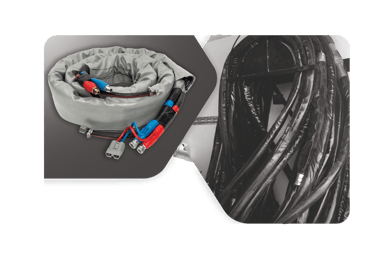 Sidewinder Scuff Guard
Sidewinder Scuff Guard
The Sidewinder Scuff Guard incorporates the most advanced insulation and abrasion-resistant materials to enhance application and provide higher yields when pushing foam. Available in both insulated and non-insulated versions, the Sidewinder installs in minutes and offers unmatched hose protection from heavy abrasion, moisture, and temperature energy loss.
Spetec Gel Reinforcing Agent
Spetec Gel Reinforcing Agent is an acrylic latex additive used to increase the strength and flexibility of our AG series of acrylic gels.
AP Lube 190
AP Lube 190 is a multi-purpose lubricant for use with both electric injection pumps and proportioner/reactor pumps.
Want more information on Alchemy-Spetec products?
Topics: All Posts, Lift Slabs, Seal Leaks

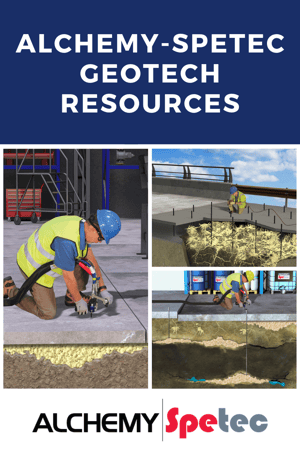 Sinking slabs and soil issues can cause both safety and property value problems. Alchemy-Spetec offers solutions for unlevel concrete and unstable soil.
Sinking slabs and soil issues can cause both safety and property value problems. Alchemy-Spetec offers solutions for unlevel concrete and unstable soil.
Concrete Leveling
A structure is only as good as the foundation it’s built on. And regardless of how well-constructed a structure may be, most foundations settle. That’s just a fact of life. Erosion, shifting soil, compaction, and many other environmental conditions tend to cause settling. Sometimes structures settle gradually, and in other cases they’re swallowed up in minutes. These situations create problems for property owners and opportunities for the contractors who know how to fix them.
Alchemy-Spetec manufactures high-strength polyurethane lifting foams for slab jacking. Among the most dependable products for jacking and leveling concrete slabs, these two-component, high-strength, hydro-insensitive structural foams serve as an extremely effective solution for contractors.
Deep Lift™ Structure Leveling
Poor compaction, water erosion, broken pipes, and organic material in the soil can all lead to
settling of a foundation or a roadway. Traditional slab lifting can bring concrete and structures
back into place but it doesn’t necessarily address the underlying issue or guarantee a long
term fix. Other methods of addressing deep soil issues require heavy equipment, extended
down time, and collateral property damage. These situations create problems for property
owners as well as opportunities for the elite contractors that know how to fix them.
Alchemy-Spetec offers a unique combination of high-strength polyurethane structural lifting foams along with the equipment and training needed to address deep soil issues. Now you can achieve soil densification and lifting on large projects with the smallest footprint and least amount of heavy equipment required. The Deep Lift™ process is powerful, painless, and rapid. Deep Lift™ gets to the root of the problems in the soil, it brings the structure back to level, and accomplishes this with minimal imposition or downtime to the property owner.
Soil Stabilization
Unstable soil can be defined as soil that will not stay in place on its own, and therefore requires
extra support. It should be noted that unstable soil can threaten the stability, security,
and safety of infrastructure and can damage, degrade, and even destroy a number of structures,
such as buildings, bridges, and roads. There are a variety of factors that can cause unstable
soil including erosion, poor compaction, freeze/thaw cycles and decomposition.
Soil can be stabilized high strength polyurethane stabilization foams. Once the bearing capacity of the
soil has been increased with this process, then the structure can be lifted if necessary.
Want more geotech resources?
Topics: All Posts, Lift Slabs, Stabilize Soil, Deep Lift
Filling Abandoned Pipes with Spetec PUR H100

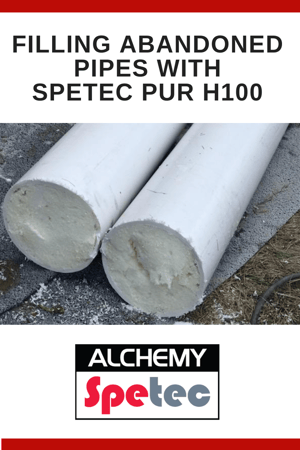 I was recently contacted by an engineer in New England who requested a demo with one of our products. Specifically, he wanted to test Spetec PUR H100 for filling abandoned pipes. In this case, we tested the material on a 6-inch diameter PVC pipe (but any type of abandoned pipe can be filled with expansive polyurethane as long as it's 30 inches in diameter or less). This pipe was 10 feet long, but there is no real length limit using the technique I describe in this blog post.
I was recently contacted by an engineer in New England who requested a demo with one of our products. Specifically, he wanted to test Spetec PUR H100 for filling abandoned pipes. In this case, we tested the material on a 6-inch diameter PVC pipe (but any type of abandoned pipe can be filled with expansive polyurethane as long as it's 30 inches in diameter or less). This pipe was 10 feet long, but there is no real length limit using the technique I describe in this blog post.
First, we plugged both ends of the pipe. We drilled a hole in the top middle of the pipe and inserted a port. We then injected the Spetec PUR H100. For longer pipes, you would place a port every 3 feet or so. You'll also want to drill one 3/8" vent hole per 10 feet of pipe, in between ports. Of course, most abandoned pipes are located underground, so your crew will have to dig down to expose top of the pipe.
Want information on other uses for Spetec PUR H100 and similar products?
Topics: All Posts, Fill Voids
Alchemy-Spetec Hires Active National Guardsman as Western Sales Representative

 Alchemy-Spetec is excited to announce the hiring of Michael Binyaminov as Western Sales Representative. Michael is a U.S. Army veteran and an active member of the National Guard. He continuously received top 25% Excel Accolades when training for officer status in the Army. He was an aviation platoon leader in the Missouri National Guard and a cavalry platoon leader in the Vermont National Guard. In every position he was a leader of his fellow soldiers. He was also given the critically important responsibility of flag bearing during military funeral honors. It was his duty to fold the flag and hand it to the next of kin at military funerals. He is still an active member of the National Guard.
Alchemy-Spetec is excited to announce the hiring of Michael Binyaminov as Western Sales Representative. Michael is a U.S. Army veteran and an active member of the National Guard. He continuously received top 25% Excel Accolades when training for officer status in the Army. He was an aviation platoon leader in the Missouri National Guard and a cavalry platoon leader in the Vermont National Guard. In every position he was a leader of his fellow soldiers. He was also given the critically important responsibility of flag bearing during military funeral honors. It was his duty to fold the flag and hand it to the next of kin at military funerals. He is still an active member of the National Guard.
As a salesman, and in life, Michael’s motto is “Never Give Up, Never Give In”. He looks forward to bringing his brand of professional persistence to helping Alchemy-Spetec customers succeed despite any and all obstacles. He credits his “true grit” approach to problem solving to his training in the Army. He was thoroughly trained in thinking outside of the box to get results. As long as the means are ethical, it’s the results that matter. Michael explains, “Regardless of the industry I am in, I have always focused on the bigger picture for the client in order to provide a full suite of solutions that best serve them in the long run. This means putting the client’s overall needs ahead of any short-term sales goals.”
Michael has been training under respected industry expert and Western Regional Manager Charlie Lerman. After Michael’s first week on the job, he told us, “My ultimate goal is to eventually be able to provide the exact same level of excellent technical assistance to our clients that Charlie Lerman currently does”.
Alchemy-Spetec V.P. of Sales and Business Development Jim Spiegel has this to say about our new recruit, "We are confident that Michael's get-it-done attitude and customer-first approach will add value for customers from day 1. He exhibits very high sales and business development acumen for someone in the initial stages of his journey. Backed by our strong senior leadership and field services team, we're excited to see Michael make strides in the industry and in his career."
Want more info on Alchemy-Spetec products?
Topics: All Posts
Alchemy-Spetec Leak Seal Resources

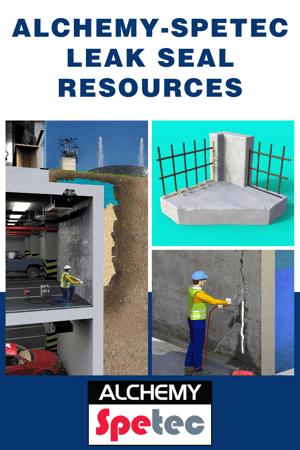 Leaking concrete can be detrimental to safety and property values. The products offered by Alchemy-Spetec deliver the ultimate solution for hairline cracks, gushing leaks and other waterstop issues.
Leaking concrete can be detrimental to safety and property values. The products offered by Alchemy-Spetec deliver the ultimate solution for hairline cracks, gushing leaks and other waterstop issues.
Sealing Leaks with Concrete Crack Injection
Concrete starts decaying immediately after it cures. Even brand new construction can require leak seal follow up work. Older concrete structures are even more susceptible. Leaks through concrete are generally going to be through cracks, joints, and honeycomb (areas in poured concrete of mainly course aggregate with voids in between). Depending on water volume and pressure, and the size of the joint or crack, you are going to encounter weeping leaks, steady leaks, and gushing leaks. These leaks can be sealed with crack injection resin.
Stopping Multiple Leaks with Curtain Wall Grouting
Curtain wall grouting is often required when cracks cannot be identified, when the walls are made of material that does not respond well to crack injection (such as masonry, stone and CMU), and when previous leak seal methods have failed. Curtain wall grouting is the process of injecting water reactive resin behind the leaking wall in a grid pattern. The water on the other side mixes with the grout and cures to a solid mass covering
the surface of the wall on the other side.
Waterstop
Newly constructed floor/wall joints with no waterstop lining can be vulnerable to water infiltration. When designers and builders neglect to line the joints, water can seep into the structure and out onto the floor. Needless to say, water on the floor can be an inconvenience, it can be a safety hazard, and it can damage property. In addition, floor/wall joint leaks can cause the concrete to decay and spall over the long run. Alchemy-Spetec offers a variety of waterstop solutions.
Want more leak seal resources?
Topics: All Posts, Seal Leaks, Waterstop
US Department of the Interior Study Finds Spetec PUR F400 Effective in Sealing Contraction Joints

The U.S. Department of the Interior and the Bureau of Reclamation recently conducted a study in which they evaluated methods for sealing contraction joints in dams. They tested 8 methods. Spetec PUR F400 was used in one of only two methods that reduced water flow 100%. We'll share some excerpts from their report in today's blog post...
The U.S. Department of the Interior protects America’s natural resources and heritage, honors our cultures and tribal communities, and supplies the energy to power our future. The mission of the Bureau of Reclamation is to manage, develop, and protect water and related resources in an environmentally and economically sound manner in the interest of the American public.
All Reclamation concrete dams have joints which experience pressure caused by the reservoir water elevation. These joints have waterstops between the formed drain and the upstream face of the dam to prevent water leakage through the joint. Over time, the waterstops can begin to leak which can become a significant maintenance issue. These leaks can lead to millions of dollars of increased maintenance costs across numerous facilities, since they corrode metalwork, increase operation costs through increased pumping to remove excess water, and reduce worker productivity as they work around the leaks, etc. In some cases, the water leaks can threaten or damage expensive equipment.
Conventional leaking contraction joint repair methods are either very expensive or do not last long. Based on work from previous years looking into cheaper repair options, where we developed an inexpensive method to deliver repair materials to a specific location deep under water, several prototype repair methods were developed. To test those methods, we built a laboratory fixture to simulate a leaking contraction joint in a dam under pressures as high as 35 psi. With this fixture we tested different repair options. These options included sawdust, hydrophilic waterstop chips, chemical grouts used for sealing water leakage through concrete, and combinations of the chips and grouts.
In this testing we found that sawdust didn’t slow the water flowing through the test fixture joint. Hydrophilic chips slowed the water by as much as 65%, and Hydrophilic chips combined with some chemical grouts completely stopped the water flow through the test fixture joint. These results could have substantial implications at Reclamation facilities with leaking contraction joints. These methods can be implemented to significantly reduce or completely stop the infiltration of water and are much cheaper than many alternatives.
Here is the product comparison table excerpted from the report...
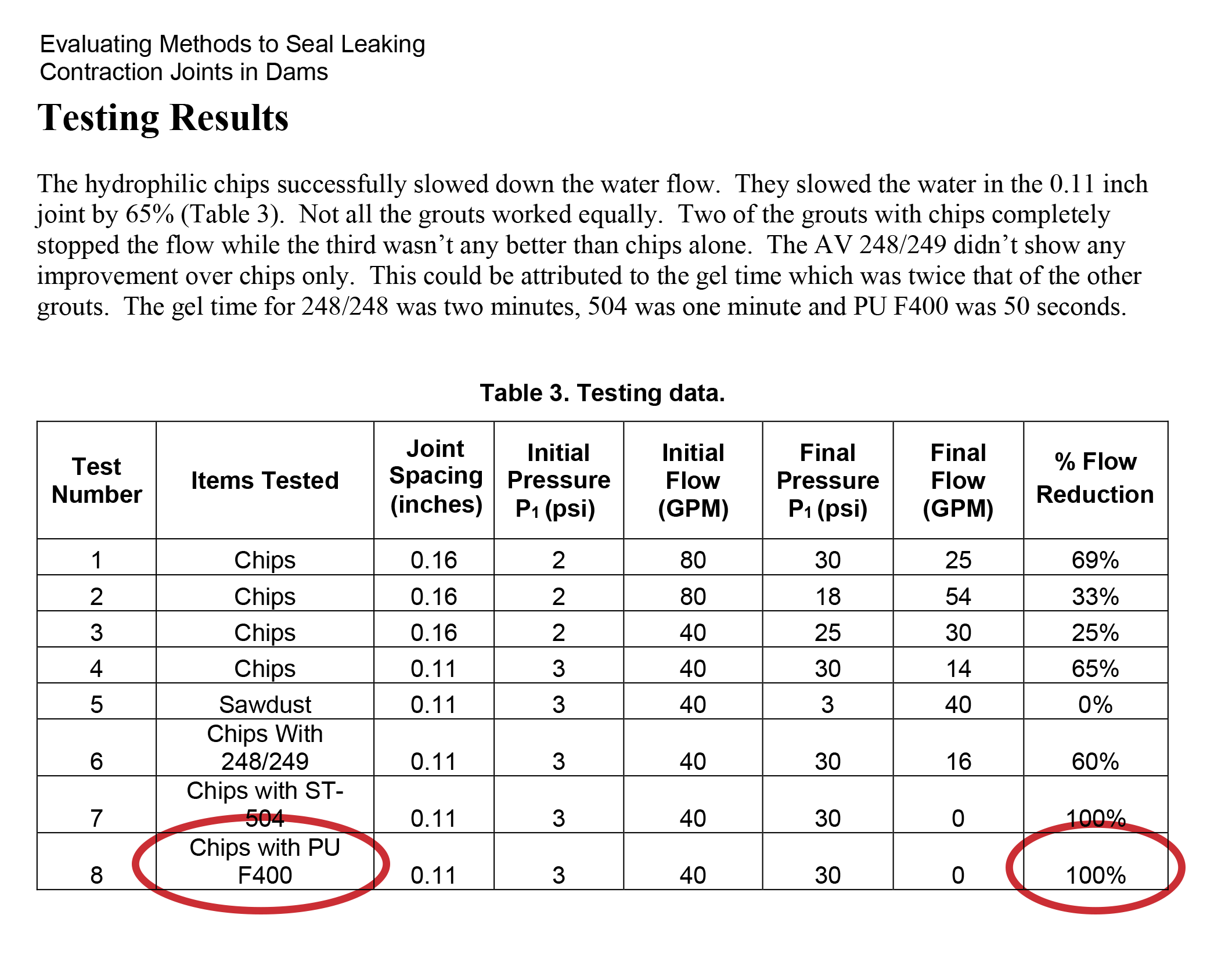
You can read more about the report here and download the entire report here.
Want more information on Alchemy-Spetec leak seal products?
Topics: All Posts, Seal Leaks
Use the High Pressure F-Valve Assembly For Twin Streaming
.png?width=1400&name=Copy%20of%20Use%20the%20High%20Pressure%20F-Valve%20Assembly%20For%20Twin%20Streaming%20(1).png)
 We've blogged about this before, but it's worth repeating. Twin streaming is a technique in which you use a high pressure 3,000 psi F-valve to inject resin AND water at the same time. As you can see in the photo, the F-valve has two supply connections - one for water and one for resin. The water and resin come into contact before they exit the coupler.
We've blogged about this before, but it's worth repeating. Twin streaming is a technique in which you use a high pressure 3,000 psi F-valve to inject resin AND water at the same time. As you can see in the photo, the F-valve has two supply connections - one for water and one for resin. The water and resin come into contact before they exit the coupler.
Advantages:
- Ensures there is enough water for the resin to react with.
- Starts the reaction immediately.
- Promotes faster reaction in cold water.
Filling Voids Above the Water Table
When working on jobs that require void filling behind walls, also known as curtain grouting, it is imperative that you are prepared for any obstacles that may occur. If the voids are large and dry, resin may not have enough water to react with when injected in the conventional manner. In this case injecting water behind the wall prior to injection might not be sufficient (especially if the void is open or filled with gravel, giving the water an easy path to escape). With twin streaming you are guaranteed there is enough water for the resin to fully react and fill the voids.
Injecting Resin Into Cold Water
Twin streaming also works well if you find yourself having to inject into a cold, underwater environment. You can inject warm water along with the resin to jump start the reaction process before the cold water gets a chance to slow down the process. The ratio of water to resin can be controlled by opening the valves at different angles. Some products such as Spetec PUR H100, Spetec PUR H200 and AP Fill 700 only need a little water to react with (10:1 resin to water is plenty). In this case, you would crack the water valve slightly, then open the resin valve all the way. Other products such as Spetec PUR GT500 and Spetec PUR GT350 need more water. A 2:1 or 1:1 ratio of resin to water both work well. In this case, you may want to open both valves all the way.
Want more info on Leak Seal products?
Topics: Equipment & Accessories, All Posts, Seal Leaks

 Alchemy-Spetec would like to take a moment to thank those who made the ultimate sacrifice in order to preserve and protect the freedoms that all Americans enjoy.
Alchemy-Spetec would like to take a moment to thank those who made the ultimate sacrifice in order to preserve and protect the freedoms that all Americans enjoy.







